5.Vocabulary plus: Complete the sentences with one of the verbs in brackets.
(Hoàn thiện các câu sau với các động từ được cho trong ngoặc.)
Our school doesn’t allow food in the science labs. (doesn’t allow/ doesn’t let)
1 My mum and dad only me watch TV when I finish all my homework. (allow/let)
2 Our parents us to play video games for more than an hour a day. (don’t allow/let)
3 Our school phones in class. (lets/bans)
4 Our dad TVs in our bedrooms. We always watch the TV downstairs together. (doesn’t allow/doesn’t let)
Cách dùng của Allow:
Diễn tả sự cho phép ai đó làm gì.
Diễn tả sự việc ai đó không bị ngăn cản làm việc gì hoặc không bị ngăn cản một điều gì đó xảy ra trong thực tế.
Allow được sử dụng để biểu hiện thái độ lịch sự khi đề nghị sự giúp đỡ từ người khác theo một cách nào đó.
Let trong một vài trường hợp có sắc thái nghĩa tương tự với allow và permit nhưng cách sử dụng của let khác với hai từ trên.
Let dùng để diễn tả về việc ai đó cho phép hoặc được phép làm gì. Nó cũng có thể được sử dụng khi bạn muốn đưa ra lời khuyên, khích lệ người khác.
Trong đa số các trường hợp let có nghĩa giống với allow nhưng sắc thái biểu đạt có phần khác. Nếu như allow được sử dụng trong cách nói trang trọng và lịch sự thì let được dùng trong những trường hợp thân mật.

Our school doesn’t allow food in the science labs.
(Trường học của chúng tôi không cho phép mang thức ăn vào phòng thí nghiệm.)
1 My mum and dad only letme watch TV when I finish all my homework.
(Mẹ và bố của tôi chỉ cho phép tôi xem TV khi tôi hoàn thành hết tất cả các bài tập.)
Giải thích: sau tân ngữ ‘me’ không có ‘to’ → let
2 Our parents don’t allow us to play video games for more than an hour a day.
(Bố mẹ của chúng tôi không cho phép chúng tôi chơi game quá 1 tiếng một ngày.)
Giải thích: sau tân ngữ ‘us’ có ‘to’ → don’t allow
3 Our school bansphones in class.
(Trường của chúng tôi cấm dùng điện thoại ở trong lớp.)
Giải thích: ‘ban’: cấm
4 Our dad doesn’t letTVs in our bedrooms. We always watch the TV downstairs together.
(Bố của chúng tôi không để TV ở trong phòng ngủ của chúng tôi. Chúng tôi luôn luôn cùng nhau xem TV ở dưới nhà)
Giải thích: câu mang tính cho phép nhưng mang tính thân mật → doesn’t let

Các bài tập cùng chuyên đề
Bài 1 :
1.Choose ONE option to complete the sentence.
(Chọn MỘT phương án để hoàn thành câu.)
1 I really want (to see / see) Bến Thành Market and the War Remnants Museum.
2 Which gate do we need (go / to go) to?
3 We (have to / have) go to Gate 34, Terminal 1.
4 We must (to catch / catch) the shuttle to Terminal 1.
Bài 2 :
2.Look at the sentences in exercise 1 and complete the Rules.
(Nhìn vào các câu trong bài tập 1 và hoàn thành các quy tắc.)
|
RULES |
|
The infinitive is the basic form of a verb. We can use it with to or without to. We use infinitives – ……….. after ordinary verbs like want, need and others. – ……….. after modal verbs like must, should and others. |
Bài 3 :
3.Complete the sentences with the correct form of the verbs in the brackets.
(Hoàn thành các câu với dạng đúng của các động từ trong ngoặc.)
1 Do you want ………… with me? (go out)
2 Can you ………… me? (help)
3 Would you like ………… with me? (dance)
4 They must ………… hard. (work)
5 You shouldn't ………… late. (stay up)
6 You don't need ………… this exercise. (do)
7 You don't have to ………… her phone. (answer)
8 We must ………… helmets while riding a motorbike. (wear)
|
Remember : (Ghi nhớ :) Typical mistakes (Những sai lầm điển hình) English learners often have mistakes like these: (Người học tiếng Anh thường mắc những lỗi như sau) – We haven’t to go to school on Sundays. (don’t have to go) Chúng tôi không phải đi học vào Chủ nhật.) – He/ She hasn’t to wear uniforms. (doesn’t have to wear) (Anh ấy / Cô ấy không phải mặc đồng phục.) |
Bài 4 :
2.Order the blocks of letters to complete the sentences.
(Sắp xếp các khối chữ cái để hoàn thành các câu.)
1 (My br) (s to b) (new c) (other w) (uy a) (ant) (ar.)
2 (He sto) (o bu) (offee.) (y a c) (pped t)
3 (She i) (o p) (ination.) (s st) (ass t) (udying h) (he exam) (ard t)
Bài 5 :
14.Write toor ✘ before the verbs.
(Viết to hoặc ✘ trước động từ.)
1 I really want ………… go out.
2 She must ………… try her best.
3 Do you need ………… stay?
4 We don't have ………… pay in cash.
5 Would you like ………… dance?
6 You cannot ………… do the test.
7 They shouldn't ………… eat much sugar.
8 Did you want ………… find your pen?
Bài 6 :
1. Put the verbs in brackets into to- infinitive or infinitive without to.
(Điền động từ trong ngoặc dưới dạng to- nguyên thể và nguyên thể không to.)
1. A: Where is John?
B: In his office. Paul asked him _______________ (send) some emails.
2. A: I’d love _______________ (see) the new computer shop.
B: We could _______________ (go) there together if you like.
3. A: Did you enjoy your visit to the science museum?
B: Yes, I managed _______________ (take) some great photos.
4. A: We hope _______________ (meet) the IT teacher this morning.
B: Can I _______________ (join) you?
5. A: Would you like _______________ (go) to the computer shop with me?
B: I’m not sure. I need _______________ (study) for my exams.
6. A: I want _______________ (buy) Modern Warfare for Tony.
B: Really? I think he can’t _______________ (play) computer games like that.
Bài 7 :
2. Complete the sentences. Then practise with your partner.
(Hoàn thành các câu. Sau đó luyện tập với bạn cùng bàn.)
1. I’d like _______________________________________________.
2. I decided _____________________________________________.
3. I promised ____________________________________________.
4. I can ________________________________________________.
5. I want _______________________________________________.
6. I agreed _____________________________________________.
7. I managed ____________________________________________.
8. I hope _______________________________________________.
Bài 8 :
3. Put the verbs in brackets into to- infinitive, infinitive without to or -ing form.
(Điền các động từ trong ngoặc ở dạng to- nguyên thể, nguyên thể không to hoặc thêm -ing.)
1. A: Would you like ________________ (watch) a film on TV?
B: Not really.
2. A: Are you going ________________ (shop) this weekend.
B: No, I’m not.
3. A: You shouldn’t ________________ (get) upset about the broken USB flash drive.
B: I just hate ________________ (lose) files, though.
4. A: I’m waiting for my new computer.
B: I hope you’ll manage ________________ (install) all the programmes you need.
5. A: Can you ________________ (show) me how to connect the TV to the laptop?
B: Not now. I’m doing my homework.
Bài 9 :
4. Put the verbs in brackets into to- infinitive, infinitive without to or -ing form.
(Điền các động từ trong ngoặc ở dạng to- nguyên thể, nguyên thể không to hoặc thêm -ing.)
1. She loves ________________ (chat) with her friends online.
2. She managed ________________ (download) the files.
3. He decided ________________ (study) computer engineering.
4. Do you fancy ________________ (come) with us to the museum?
5. How can I ________________ (help) you?
6. I hate ________________ (listen) to classical music.
7. I can’t ________________ (fix) this laptop.
8. I promised ________________ (give) Ann a new mouse on her birthday.
Bài 10 :
Grammar
3. Put the verbs in brackets into the to- infinitive, infinitive without to or -ing form.
(Chia các động từ trong ngoặc thành dạng to- nguyên thể, nguyên thể không to hoặc dạng -ing.)
1. Would you like to ______ (see) it?
2. She decided to ______ (join) the game competition.
3. He agreed to ______ (share) the computer with me.
4. You mustn’t ______ (tell) lies.
5. He can’t ______ (learn) to drive.
6. I love ______ (surf) online.
7. I’d like to ______ (go) out tonight.
8. She wants to ______ (get) a laptop.
9. I hate ______ (listen) to jazz music.
10. He promised to ______ (help) me.
Bài 11 :
Infinitive (to - infinitive, infinitive without to)/ -ing form.
1. Choose the correct option.
(Chọn câu trả lời thích hợp)
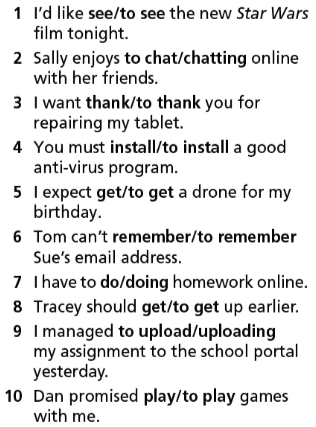
Bài 12 :
2. Put the verbs in brackets into to-infinitive or infinitive without to.
(Đặt động từ trong ngoặc thành dạng to V haowjc V nguyên mẫu.)
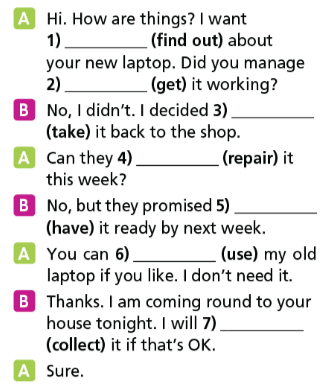
Bài 13 :
3. Put the verbs in brackets into to infinitive, infinitive without to, Ving form.
(Đặt các động từ trong ngaowcj thành dạng to V, V nguyên mẫu, Ving.)
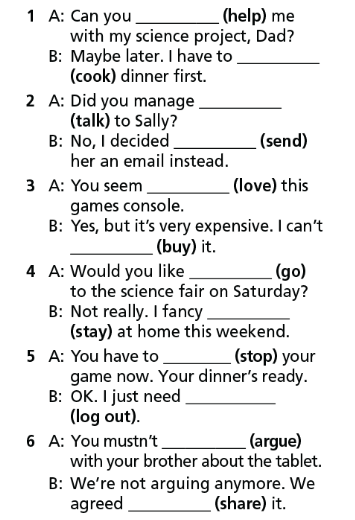
Bài 14 :
4. Find eight grammar mistakes in the email and correct them.
(Tìm 5 lỗi trong mẫu thư điện tử và sửa lại.)

Bài 15 :
9. Put the verbs in brackets into To infinitive, the infinitive without to, Ving form.
(Đặt các động từ trong ngoặc thành dạng to V, Ving, V nguyên mẫu.)

Bài 16 :
1. Complete the table with ‘infinitives with to’ or ‘infinitives without to’.
(Hoàn thành bảng với ‘infinitives with to’ hoặc ‘infinitives without to’.)
|
used to, have to, ought to |
|
|
must, can, will, should,may, had better, needn’t |
|
|
want, need, would like |
Bài 17 :
2. Make questions and give short answers.
(Đặt câu hỏi và đưa ra câu trả lời ngắn gọn.)
1 you/use to / commute to school / the school shuttle bus?
Yes,
No,
2 you /have / work overtime / Sundays ?
Yes,
No,
3 you /want/ take part in /Young Musician of the Year /contest?
Yes,
No,
Bài 18 :
3. Circle the best option to complete the sentences.
(Khoanh tròn lựa chọn tốt nhất để hoàn thành câu.)
1 She used to /has to / must to stay inside or she will pay a fine.
2 Alice wants to fly / fly /flying to a wonderland.
3 You needn’t go / to go /going with us.
4 Would you like swim / to swim / swimming, Jane?
5 You ought to / had better not / should not work hard or you will fail the test.
6 We needn’t / don’t need / not need to hurry because we have much time.
Bài 19 :
4. Complete the table with more verbs. Don’t use the verbs in exercise 1 again.
(Hoàn thành bảng với nhiều động từ hơn. Không sử dụng lại các động từ trong bài tập 1.)
|
infinitives with to |
infinitives without to |
|
|
Bài 20 :
Infinitives: with to or without to
1.Write to or Ø in the blanks.
(Điền to hoặc không to vào chỗ trống.)
1 want do something
2 need do something
3 can do something
4 should do something
5 would like do something
6 may do something
7 ought do something
8 used do something
9 have do something
10 must do something
Bài 21 :
2. Complete the sentences using the affirmative or negative form of the verbs.
(Hoàn thành các câu với dạng khẳng định hoặc phủ định của động từ.)
|
swim run eat study play read drink |
You should not drink so mụch Coke because it's not good for your health.
(Bạn không nên uống Coca vì nó không tốt cho sức khỏe.)
1 It’s cold today. You should
2 You can many vegetables as they are good for your health.
3 You must soccer in this restricted area.
4 You have hard so as to get high grades.
5 You ought these fairy tales to build your imagination.
6 You can faster if you have lighter shoes.
Bài 22 :
Infinitive ( to Infinitive, Infinitive without to)/ -ing form
51. Choose the correct option.
( Chọn đáp án đúng.)
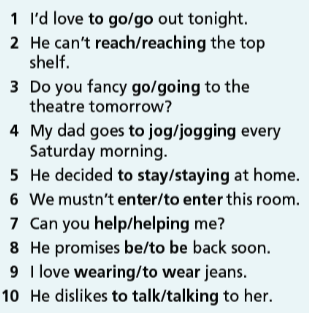
Bài 23 :
52. Put the verbs in brackets into to Infinitive, Infinitive without to or -ing form.
( Đặt các động từ trong ngoặc ở dạng to Infinitive, Infinitive without to hoặc -ing.)
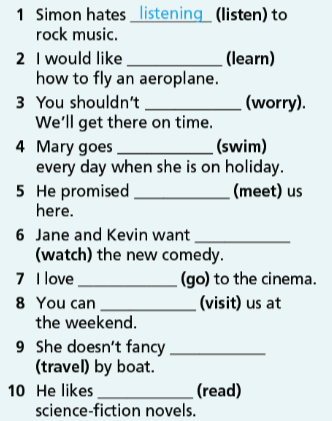
Bài 24 :
53. Put the verbs in brackets into to Infinitive, Infinitive without to or -ing form.
( Đặt các động từ trong ngoặc ở dạng to Infinitive, Infinitive without to or -ing.)

Bài 25 :
54. Put the verbs in brackets into to Infinitive, Infinitive without to or -ing form.
( Đặt các động từ trong ngoặc ở dạng to Infinitive, Infinitive without to or -ing.)

Bài 26 :
55. Choose the correct option.
( Chọn đáp án đúng.)

-
Choose the correct option. ( Chọn đáp án đúng.)

















